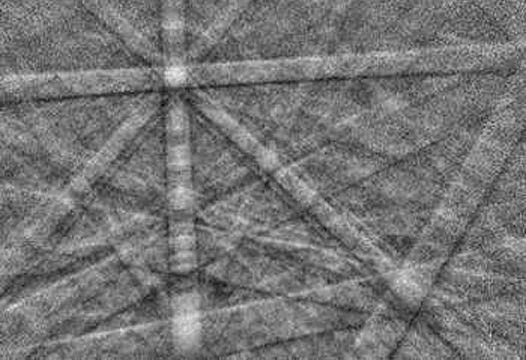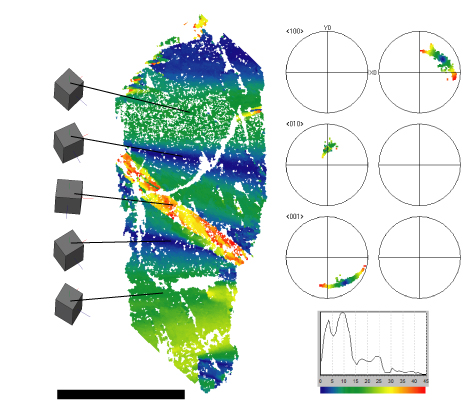- Yang, T., Chen, H., Jia, Z., Deng, Z., Chen, L., Peterman, E.M., Weaver, J.C., and Li, L., 2022, A natural dual-scale single-crystalline architected lattice material. Science, v. 375, issue 6851, p. 647-652. https://doi.org/10.1126/science.abj9472
- Peterman, E.M., Jercinovic, M.J., Beane, R.J., and de Wet, C.B., 2021, Kyanite preserves prograde and retrograde metamorphic events as revealed by cathodoluminescence, geochemistry and crystallographic orientation. Journal of Metamorphic Geology, p. 1-24. https://doi.org/10.1111/jmg.12593
- Peterman, E.M., Reddy, S.M., Saxey, D.W., Snoeyenbos, D.R., Rickard, W.D.A., and Fougerouse, D., 2019, Nanoscale processes of trace element mobility in metamorphosed zircon, Contributions to Mineralogy and Petrology, v. 174, no. 92, 29 pp. https://doi.org/10.1007/s00410-019-1631-1
- Peterman, E.M., Reddy, S.M, Saxey, D.W., Snoeyenbos, D.R., Rickard, W.D.A., Fougerouse, D., and Kylander-Clark, A.R.C., 2016, Nanogeochronology of discordant zircon measured by atom probe microscopy of Pb-enriched dislocation loops. Science Advances, v. 2, e:1601218, 9 pages. doi: 10.1126/sciadv.1601318
- Peterman, E.M., Snoeyenbos, D.R., Jercinovic, M.J., and Kylander-Clark, A., 2016, Dissolution-reprecipitation metasomatism and growth of zircon within phosphatic garnet in metapelites from western Massachusetts. American Mineralogist, v. 101, p. 1792-1806. https://doi.org/10.2138/am-2016-5524
- Grew, E.S., Yates, M.G., Beane, R.J., Floss, C. and Gerbi, C., accepted. Chopinite-sarcopside solid solution, [(Mg,Fe)_3 ](PO_4 )_2 ,in GRA95209, a transitional acapulcoite: Implications for phosphate genesis in meteorites. American Mineralogist.
- Johnson, S.E., Lenferink, H.J., Price, N.A., Marsh, J.H., Koons, P.O., West, D.P., and Beane, R.J., accepted. Clast-based kinematic vorticity gauges: the effects of slip at matrix/clast interfaces. Journal of Structural Geology
- Beane, R.J. and Field, C., 2007. Kyanite deformation in whiteschist of the UHPM Kokchetav Massif, Kazakhstan. Journal of Metamorphic Geology v. 25, p. 117-128.
- Hawkins, A.T., Selverstone, J., Brearley, A.J., Beane, R.J., Carlson, W.D. and Ketcham, R., 2007. Origin and mechanical significance of honeycomb garnets in high-pressure metasedimentary rocks from the Tauern Window, Eastern Alps. Journal of Metamorphic Geology v 25, p. 565-583.
- Beane, R. J., 2004. Using the scanning electron microscope for discovery based learning in undergraduate courses. Journal of Geoscience Education, v. 52, p. 250-253.
- Msall, M.E., Dietsche, W., Beane, R., Wichard, R. and Carpenter, J.*, 2004. Examination of an unusual grain boundary in CaF2. Physica Status Solidi (c), v. 1, no. 11, p. 2983-2986.
- Beane, R. J. and Prior, D.J. in revision. Crystallographic orientation evidence for the formation of atoll garnet in eclogite. Geology.
Electron Backscatter Diffraction (EBSD)
Overview
Bowdoin College's first electron backscatter diffraction (EBSD) system was purchased with funds awarded through the NSF Major Research Instrumentation (MRI) program (proposal 0320871 funded to Rachel Beane). In 2016, an upgraded instrument was purchased with funds awarded through the NSF MRI program (proposal 1530963 awarded to Emily Peterman and Rachel Beane).
Features
The EBSD system, by Oxford Instruments, includes a NordlysMax3 EBSD Detector, forescatter detectors, and software used for orientation mapping (stage and beam control), texture determination, and phase identification (using the American Mineralogist Geological Phase database).
The system is attached to the Tescan VEGA3 LMU VP SEM (variable pressure scanning electron microscope) and often works in tandem with the Oxford Instruments X-Max50 energy dispersive spectrometer (EDS) for measuring mineral chemistry.
How it Works
The EBSD system uses backscattered electrons (BSE) emitted from a specimen in a SEM to form a diffraction pattern that is imaged on a phosphor screen.
Analysis of the diffraction pattern allows identification of the phase and its crystal lattice orientation.
The scanning and mapping capabilities of the system permit rapid acquisition of data, from polished rock thin sections and (bio)mineral specimens, at sub-micron resolutions.
Among other uses, these data may be applied to evaluate crystallographic preferred orientations (CPO) of mineral fabrics, and to examine misorientation axes and angles that may signify processes such as subgrain development and dislocation creep.


Methods
The typical methods this lab uses for collection and processing of EBSD data follow. Specific projects will vary from these methods.
Electron backscatter diffraction (EBSD) analyses are conducted at Bowdoin College on a Tescan VEGA3 SEM outfitted with an Oxford Instruments NordlysMax3 detector. Data were processed using AZtec and Channel 5 software. Samples are prepared by affixing standard polished thin sections to a halved brass rods (M. Cheadle, personal communication) and polishing an additional three hours in a non-crystallizing colloidal silica suspension on a Buehler Vibromet2 vibratory polisher (SYTON method of Fynn and Powell, 1979).
Thin sections are coated with a thin (ca. 5 nm) carbon coat to minimize charge. For samples that are not carbon coated, charging is minimized by using a chamber pressure of 10-15 Pa, combined with the 70° tilt. Operating parameters for collecting EBSD patterns are an accelerating voltage of 20kV, working distance of 25 mm, and probe current of 1-3nA.
Channel 5 acquisition and indexing settings vary by phase, but typical values are 2x2 or 4x4 binning, high gain, Hough resolution=60, 8 bands, and 80 reflectors. Mean angular deviations between the detected Kikuchi bands and the simulations are less than 1.3 degrees (and often less than 0.8 degrees). Data are post-processed by removing wild spikes, removing observed systematic misindexing, and by extrapolating zero solutions based on 4-6 neighbors (if required).